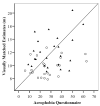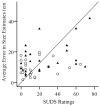The roles of altitude and fear in the perception of height
- PMID: 19331498
- PMCID: PMC3398806
- DOI: 10.1037/a0013894
The roles of altitude and fear in the perception of height
Abstract
Previous research on perceiving spatial layout has found that people often exhibit normative biases in their perception of the environment. For instance, slant is typically overestimated and distance is usually underestimated. Surprisingly, however, the perception of height has rarely been studied. The present experiments examined the perception of height when viewed from the top (e.g., looking down) or from the bottom (e.g., looking up). Multiple measures were adapted from previous studies of horizontal extents to assess the perception of height. Across all of the measures, a large, consistent bias was found: Vertical distances were greatly overestimated, especially from the top. Secondary findings suggest that the overestimation of distance and size that occurs when looking down from a high place correlates with reports of trait- and state-level fear of heights, suggesting that height overestimation may be due, in part, to fear.
(c) 2009 APA, all rights reserved.
Figures











References
-
- Amorim M-A, Loomis JM, Fukusima SS. Reproduction of object shape is more accurate without the continued availability of visual information. Perception. 1998;27:69–86. - PubMed
-
- Andre J, Rogers S. Using verbal and blind-walking distance estimates to investigate the two-visual systems hypothesis. Perception & Psychophysics. in press. - PubMed
-
- Bhalla M, Proffitt DR. Visual-Motor Recalibration in Geographical Slant Perception. Journal of Experimental Psychology: Human Perception and Performance. 1999;25(4):1–21. - PubMed
-
- Bolles RC, Bailey DE. Importance of object recognition in size constancy. Journal of Experimental Psychology. 1956;51:222–225. - PubMed
-
- Bouchard S, St-Jacques J, Robillard G, Cote S, Renaud P. Efficacy of a virtual reality exposure treatment for acrophobia: A preliminary study. Journal de Therapie Comportementale et Cognitive. 2003;13:107–112.

